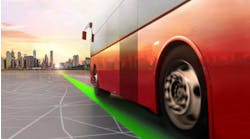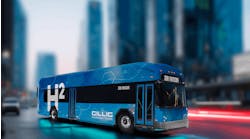Amid the backdrop of wildfires, hurricanes and global concerns from climate scientists, there is hope. While both the infrastructure bill and reconciliation bills working their way through Congress have the potential to make a significant dent in greenhouse gas (GHG) emissions, individual states are acting on their own.
Last month, Illinois passed its Climate and Equitable Jobs Act into law. In addition to setting a 2045 date to eliminate coal and fossil fuel as sources of electricity, the plan sets up new rebates for electric vehicles (EVs) and charging infrastructure. A week later, Pennsylvania released a plan targeting an 80 percent reduction of GHGs by 2050, part of which includes moving to zero-emission transit and school buses. In California, a few days later, the state earmarked $3.9 billion for EV purchases, including thousands of buses and drayage trucks, while prioritizing projects that benefit disadvantaged communities.
The environmental impact of medium and heavy-duty vehicles cannot be understated. Twenty-nine percent of U.S. GHG emissions come from the transportation sector, making it the largest source of U.S. greenhouse gas emissions. While making up only 10 percent of all vehicles on the road, heavy-duty vehicles are responsible for a whopping 24 percent of GHG emissions and 57 percent of on-road, direct PM2.5 emissions (particulate matter less than 2.5 micrometers).
The urgency to address the ill effects of climate change is reaching a critical mass. Billions of state and federal dollars are about to be spent on something that has never been done before – transitioning our entire transportation sector away from harmful fossil fuels. The success thus far in zero-emission transportation is significant. Mass Transit magazine’s 2021 Mobility Report shows that the majority of U.S. transit agencies are planning a battery-electric bus purchase in 2021, and more than 80 percent have zero emission plans. But we are still in the early adoption phase. The technologies we use today may not necessarily scale to meet our clean energy goals. As they always have when humankind has embarked on herculean tasks, new and emerging technologies will play a critical role in our success.
Regardless of market sector or vehicle class, many on the fence are waiting for higher-capacity batteries and ways to make charging faster and less disruptive. Investment decisions should include start-ups, universities and innovators whose technologies aim to overcome these barriers. Moreover, state and federal incentive programs do not always cover forward-looking technologies. Their exclusion can keep these technologies from reaching the critical economies of scale needed to compete, succeed and solve electrification problems at scale.
Heavy-duty vehicles such as battery-electric buses use up to 10 times more power than passenger vehicles, and the technical challenges associated with fast charging scale accordingly. For example, at higher power levels, especially those needed to charge buses and heavy-duty trucks, the weight and heat of larger plug-in cables become unmanageable. Speak to any fleet operator about their primary concerns with the transition to EVs, and universally, you will hear concerns about range, duty cycle and the labor impact of charging entire fleets.
One solution to this challenge is wireless inductive charging, which was developed using research from Utah State University. Chargers embedded in the roadway deliver high power to buses and trucks quickly and safely during scheduled stops. And wireless charging avoids any overheard charging gear, ground clutter or heavy cables – all challenges to deploying electric buses at scale.
While this may sound like a futuristic technology to some, wireless charging has been used by the Antelope Valley Transit Authority in Northern Los Angeles County since 2016. In doing so, AVTA became the first transit agency in the U.S. to transition to a fully electric local bus fleet, helping to pave the way for new problem-solving technology to be deployed at scale. Automated and hands-free operation makes the system ideal for autonomous vehicles too.
Vehicle-to-grid (V2G) integration is another critical technology. Electric vehicles equipped with bi-directional charging/discharging technology can send power back to homes, buildings or the grid when needed. The ability to monetize megawatts of stored energy in fleet batteries could prove to be a financial incentive for operators to electricity. While V2G functionality is making its way into vehicles such as the upcoming Ford F-150 Lightning, coordinated efforts among policymakers, vehicle manufacturers and energy producers will be needed in order for the technology to have a measurable impact in a timely manner.
One carryover from today’s fossil fuel-based infrastructure we do want to take with us is the ability for cars and trucks to be refueled at any fueling station. Today’s complicated patchwork of charging networks, each with different software and connector requirements, is another barrier to electric vehicle adoption.
Federal and state support of standards adoption from internationally recognized bodies can help here. Following and engaging in standards-setting discussions and encouraging alignment around a common set of standards in regulation would help overcome interoperability challenges and accelerate adoption.
Regardless of market sector or vehicle class, many on the fence are waiting for higher-capacity batteries and ways to make charging faster and less disruptive. Yet those who embrace technologies early are reaping electrification rewards right now.
-------
Michael Masquelier is the chief technology officer at WAVE (Wireless Advanced Vehicle Electrification) in Salt Lake City, Utah. He also serves as co-chair of the SAE J2954 Heavy Duty standards committee on wireless charging of electric vehicles.




